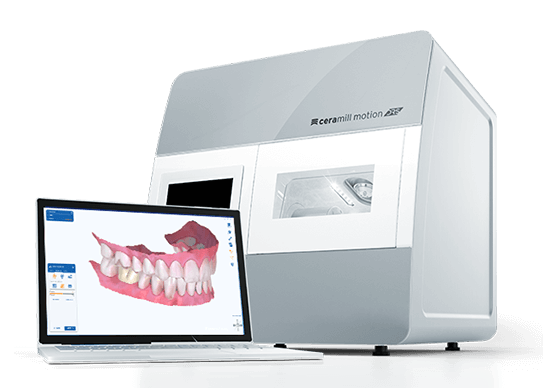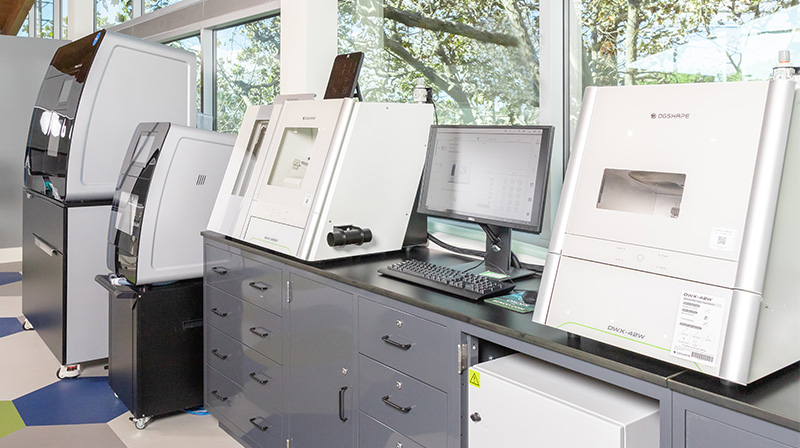

Dental milling machines take the digital impression and design a clinician has created to mill restorations in the same day. Since mills are located chairside (in office), clinicians can place restorations in a single office visit. Patients enjoy the instant results and clinicians can perform more procedures in office.
Buying a dental milling machine is a big – and often confusing – decision. From dry or wet milling to chairside or laboratory mills, the options appear to be endless.
The spindle is the heart of any milling machine. It consists of an encapsulated motor inside the mill that spins the cutting tool (bur). The milling program generated by CAM software tells the controller inside the milling machine how fast the spindle should spin.

100% financing means you’ll hit the ground running. Plus, your cash remains untouched and
intact for savings, working capital or expenses.
You’ll get the things you need upfront, with no waiting.
Looking to learn more about intraoral scanners? Read through our frequently asked questions
to better understand how intraoral scanners can help your practice!
The type of material being milled determines whether a mill should be dry or wet. Certain ceramic materials such as lithium disilicate and feldspathic porcelains require wet milling, as do some metals like chrome cobalt and titanium. Other materials, including some zirconia can be milled dry or wet.
The liquid in a wet mill serves several functions. It continuously bathes the cutting tool and milling stock, keeping both the tool and material cool, and helps to remove material from the milling disk or block. Certain additives can also be included in the liquid to act as a cutting lubricant. Wet mills require periodic cleaning because the material milled away collects within the machine and eventually needs to be removed.
Dry milling does not use liquid to remove scrap material from the cutting surface, but rather pressurized air, vacuum, or a combination of both. Maintenance cleaning is still required, as a considerable amount of dust and shavings are generated with dry milling. Vacuum size, noise, and operating expense should all be considered before making a purchase.
Most mills are configured to operate as either a wet or dry mill. However, some dry mills can be converted to operate as a wet mill. Others can operate as dry or wet depending on the material being milled.
Mills are available in three basic sizes: tabletop, bench-top and standalone.
A tabletop mill is usually small enough that a single person can pick it up and move it from location to location. These mills typically use belt-drives to move the stock or milling spindle. Most tabletop mills are configured to mill single-unit blocks.
While the most common dental mills have tool changers to swap burs (tools) during milling, some of the tabletop mills have fixed tooling that must be manually changed during the milling process. The price of tabletop mills ranges from an estimated $30,000 to $50,000.
These smaller mills may have tool usage and changing limitations. In addition, while smaller and lighter mill construction improves portability and keeps system cost low, they may also limit the lifetime and tolerances of certain key system components.
Bench-top mills tend to be considerably larger and heavier than the tabletop versions. Bench-top mills generally use heavy-duty ball screws to move the stock or milling spindle. Bench-top mill spindles are also typically more robust than those found in tabletop mills. Automatic tool changers are standard, and in some cases, extra tool positions are available for additional milling detail or other materials. Some bench-top mills are also capable of milling metal and glass ceramics in certain configurations. The price range for bench-top mills can range from $50,000 to $150,000. This is because of their more durable construction, which makes them better suited for heavy usage.
Freestanding mills are typically the biggest, most robust and most expensive mills available. They can mill the toughest materials, in larger stocks, and run longer with tighter tolerances than the smaller mills. Prices for freestanding mills can range from $100,000 to $500,000. If a fixture is available to hold a material, these mills can mill anything that the smaller mills can. With these massive machines, the question concerns which materials and products would generate enough revenue to justify the expense.
CAM software determines how to mill a part out of the stock material and generates a milling program for the mill to follow. Some CAM programs are integrated into the CAD or design software, others act as standalone separate programs. The CAM software must be configured with specific information about the mill, including the size and shape of the cutting tools, the material being milled, the spindle controller, and the motors that move or rotate the stock and spindle. Fortunately, this is usually taken care of by the manufacturer or the company supplying the CAM software for the mill. Laboratories looking to upgrade or add mills should always investigate whether their existing CAM software will work with the new equipment.
Most milling sequences are broken down into three basic routines: roughing, finishing and detail. The routines always occur in this order. Each routine has its own set of step-over and step-down values. Step-over is the distance that the mill moves over, usually horizontally, before it makes the next milling pass; and step-down is the distance that the mill moves down, usually vertically, for the next pass.
Roughing is the step where bulk material is removed quickly. It usually is done with the largest- diameter cutting tool available. The spindle speed and cutting travel speed are usually at the fastest settings. Step-over and step-down values are the highest, removing as much material as possible.
Finishing is an intermediate step that removes the material left over from roughing. A smaller tool is used during the finishing sequence. Step-down and step-over values are much smaller, which results in a better surface finish. In the finishing step, because the tools are smaller and areas like margins are being milled, the feed-rate is usually slower. Sometimes there are multiple finishing sequences. The CAM software may use one strategy with certain step-overs and step-downs for axial walls, use a different one for margins, and yet another one for occlusal anatomy.
We’re happy to help you with any additional questions! Please fill in the form below, and a member of our
OneVisit team will reach out to you.